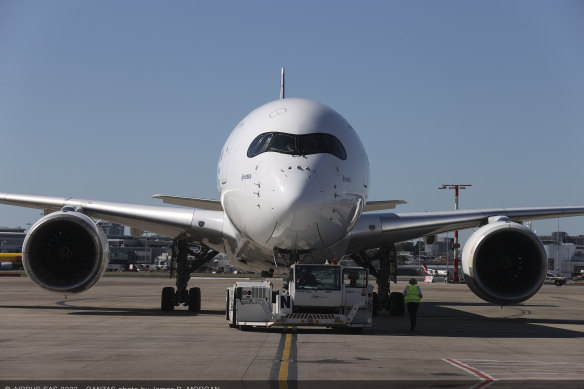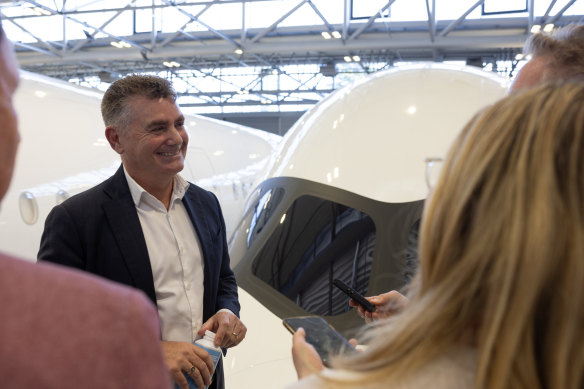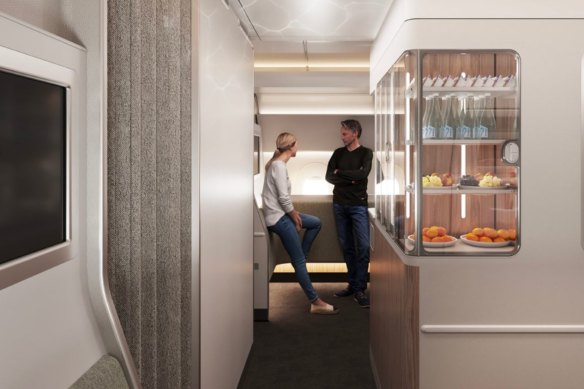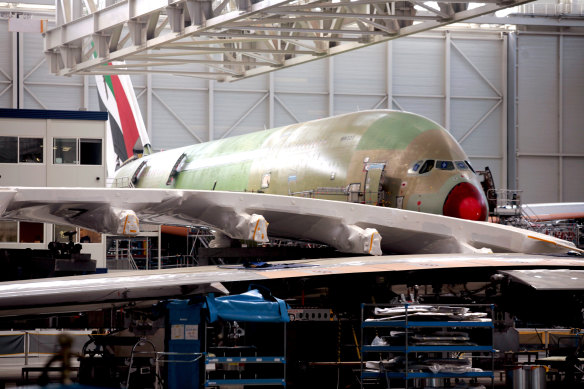Toulouse: Airbus engineer Tom Lefevre has just paused for a fourth time to deliver yet another safety reminder to a scrum of unruly Australian reporters on tour of the final A350 assembly line.
He says it’s normal for the manufacturer’s engineers to be subject to up to five safety briefings per shift and admits the quality assurance problems at rival manufacturer Boeing have caused everyone at Airbus to be on red alert.

The Airbus A350 flies some of the world’s longest non-stop routes. Qantas is banking on it to boost the airline’s international margins from 2026.
Above him is a somewhat ominous sign which reads “31 days without accident. Record: 120”.
“It can be sometimes difficult to find a good balance. You don’t want to be too focused on it that it disrupts your work. We already have safety reminders in place but the Boeing problems have reinforced the need,” Lefevre said.
The Airbus A350 is the manufacturer’s newest wide body twin engine aircraft, which was first created in response to Boeing’s 787 Dreamliner and then redesigned to be made lighter and more cost-efficient following a poor uptake in orders for its first iteration.
Qantas is banking on its order of 12 A350s, due to arrive from mid-2026 with a customised forth rear centre fuel tank, to fly non-stop services to Europe and the US from Australia’s east coast (Project Sunrise). The 22-hour flights will be the longest in the world, and the airline is expecting passengers to cough up 20 per cent more for the privilege.
For now, Qantas and Airbus have an exclusivity arrangement that prevents other airlines from receiving a four-tank A350, known as the A350-1000 ULR, until Qantas’ order has been fulfiled. Airbus is cagey on which other airlines may be eyeing it off and how much they may have to pay, but insists that Australia is not the only market for extra-long haul flights.
Former Air New Zealand executive and now boss of Qantas International, Cam Wallace, admits he never expected Project Sunrise to get off the ground when he first saw a tweet exchange between Airbus and Qantas about the concept in 2017.
“ I told them it’s a PR stunt. Nothing to worry about. It will never come to fruition,” he said, recalling the moment three or four public relations employees sprinted to his office.
“I then went and said the same thing to the board with extreme confidence,” Wallace says.

Qantas head of international Cam Wallace on a tour of Airnbus’ factory in Toulouse, France. Credit: Airbus
Wallace is now relying on the appeal of non-stop flights to boost Qantas International’s margins, which is expected to miss its target of more than 8 per cent this year. This EBIT target will increase to above 10 per cent when Sunrise launches in FY25. Qantas controls 60 per cent of the domestic market but flies just 17 per cent of passengers internationally.
It’s Wallace’s job to boost international market share, and he says ultra-long haul is the way to do so. “I talk to the team about smart growth – we need to bulk up and grow, but we need to grow in the right places at the right time with the right aircraft, targeting the right customers,” he said.
He argues competitive advantage in aviation has largely been driven by product design changes like lie-flat beds and in-flight entertainment or free Wi-Fi, which can be easily replicated.
“What we’re trying to do with Sunrise is get a network advantage, which means it’s harder to compete with,” he said.
There are many who doubt anyone will want to pay 20 per cent more to fly 22-hours crammed into one of Qantas’ 140 44 inch economy seats. The airline has made no secret it’s banking on the bulk of the returns to be driven by its premium heavy cabin configuration, with 40 premium economy seats, 52 business seats and 6 first suites.
The airline has designed a “wellness zone” to allow economy and premium economy passengers to stretch, drink water and snack on a banana or two during the long journey. There is no bar.
Designer David Caon said the wellness zone is not about the consumption of alcohol, and even considered putting in exercise bikes at one point before deciding sweating should not be encouraged.
Qantas is forking out $15 billion on fleet renewal and waiting for 59 new aircraft to be delivered over the next three years after long being criticised for its outdated fleet. Meanwhile, the industry is now grappling with industry-wide aircraft delays, which has thrown the meticulous planning of some airlines completely out the window and leaves Qantas near the front of the order queue.

Qantas’ Wellbeing Zone on board its non-stop flights from Australia’s east coast to London and New York took out the passenger comfort award.
Qantas has ordered 40 Airbus A321 XLRs and A220s to fly the bulk of its domestic routes and replace its old Boeing 737s and 717s.
The first two of its A220s have already arrived and are in use across QantasLink operations. It has also purchased 12 A350s and 12 B787s for its long haul operations and will phase out the existing A330s.
While Qantas has not fully escaped the manufacturing delays, it is less exposed than many of its competitors.
Its A350S are now not expected to be delivered until mid-2026. The first A321 XLR delivery has been pushed back to early 2025, three months after it was initially expected. The airline said it has not been advised of further delays to any order since February.
Airbus’ global marketing leader Joost van der Heijden said the A321 XLR order is a game changer for short-haul international and domestic operations.
“They are 25 per cent more fuel efficient than the previous generation. That allows airlines to profitably open routes that are today too thin for wide body aircraft. The XLRs have the capacity and the range to open the routes and grow them to wide bodies later on,” van der Heijden said.

An A380 during its assembly at Airbus’ factory in Toulouse, France.Credit: Getty Images
Airbus does not comment on the status of deliveries and its executive team are reluctant to weigh in on the quality assurance crisis befalling its only major competitor, and instead repeat the safety messaging we heard four times on the factory floor.
One Airbus engineer, who was not authorised to speak publicly, said this isn’t surprising. None of the aircraft innovation we’ve been told about will mean much if public confidence in the safety of aviation weans.
“The situation at Boeing is bad for all of us, no one wants to make it worse. We need strong competition and quality assurance, or we all suffer,” he said.
This reporter travelled to Paris and Toulouse as a guest of Qantas and Airbus.
The Business Briefing newsletter delivers major stories, exclusive coverage and expert opinion. Sign up to get it every weekday morning.
clarification
This article has been updated with the latest data on Qantas International’s margin and earnings targets.